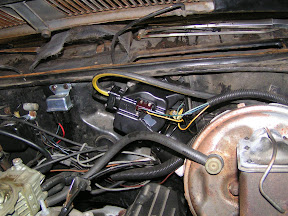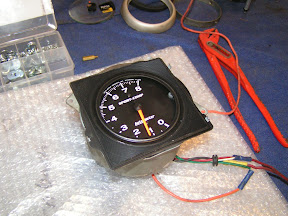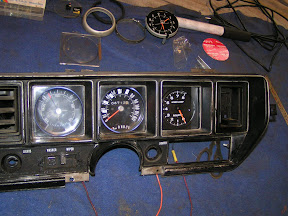I just spoke with the company that helps me find parts for my car about headers as the one on the passenger side of the car is busted.
Initially I was told that they'd cost about 2000 Skr ($280) but I wanted to go for the TA Performance headers so I asked them for a price quote on those (they cost $445 in the States at the time of writing).
They couldn't get headers from TA but quoted me for a pair of Hooker headers instead. Unfortunately these would cost me 7595 Skr ($1060). A lot of money indeed.
So now I'll have to wait with headers until the next winter and then I'll most likely get the TA Performance headers directly from them as those are the ones I want (plus, they'll most likely be cheaper - even after shipping, VAT and customs).
For this summer I'll just weld the existing ones into usable shape.
Wednesday, February 21, 2007
Sunday, February 18, 2007
Almost all the dash electronics done
 The parts I ordered for my car came in this week; a new wiper/washer motor/pump (I was told it'd be new but it was in fact remanufactured), a relay for the fan motor and light bulbs for the dash lights.
The parts I ordered for my car came in this week; a new wiper/washer motor/pump (I was told it'd be new but it was in fact remanufactured), a relay for the fan motor and light bulbs for the dash lights.First up was the fan relay as this was the easiest one. It's not ideally located but I've got long arms so I got it back in there. Only problem was that when I went to test it all out the fan only worked at the Low setting. Sigh.
I took out the voltmeter and checked all the connections and they all had proper voltage. I followed the wiring, testing bit by bit, until I got to the fan resistor. After jostling that about the fan worked as it should so I'll take a closer look at it later on.
Next up was the wiper motor. As I mentioned above I was expecting a new unit but got a remanufactured one. There's still warranty on it and it's not extremely difficult to replace but it'd be nice to have a new one in there.
The mechanical installation wasn't all too difficult. I had to widen the gap in the plate that connects directly to the motor shaft as it was 0.1 mm to narrow. The real worries began when I hooked up the electronics.
At first it all seemed fine; the wipers and the washer pump all operated as they should but when I tried to turn the wipers off - they just kept going up and down in very small movements just at the lower turning point.
 I was stumped and had no idea what it could be. I started measuring voltages just about everywhere but it all looked just fine. I finally realised that I should probably check the Fisher Body manual and after about 10 minutes of reading I located this exact problem and how to troubleshoot it.
I was stumped and had no idea what it could be. I started measuring voltages just about everywhere but it all looked just fine. I finally realised that I should probably check the Fisher Body manual and after about 10 minutes of reading I located this exact problem and how to troubleshoot it.It turned out to be the ground to the dash controls for the wiper/washer. When testing I just hooked the control switch on to the connector so there was no ground what so ever. After temporarily screwing it to the dash sheet metal the wipers worked as they should.
Rejoice!
Reijo was going to help me listen for unwanted engine sounds but he was away on an errand so I started removing old tape residue from the vinyl roof while I waited for him. As to why there's tape residue to begin with I have only myself to blame.
When the car started to take in water during the autumn rains that plagued Sweden for the better part of three months I taped over every trimming on the roof, hoping that It'd keep tight(er). It didn't help at all.
 All that it did was cling to the chrome and vinyl making it almost impossible to remove. First I tried with paint thinner but it seemed a bit too aggressive against the vinyl so I bought another solvent, designed to remove old glue. I got most of it off but I'll need to go over it again later on.
All that it did was cling to the chrome and vinyl making it almost impossible to remove. First I tried with paint thinner but it seemed a bit too aggressive against the vinyl so I bought another solvent, designed to remove old glue. I got most of it off but I'll need to go over it again later on.After Reijo got back he brought out the stethoscope and listened to the engine for 5-10 minutes while I took it from idle to about 1500 RPMs. The good news is that he couldn't hear any actual noise coming from within the engine besides some very minor rattling from the valves but not enough to worry about.
There still was a sharp, clonking noise coming in relatively regular intervals. I've always attributed that to a header hitting the frame as it goes away as soon as you rev the engine past idle but Reijo wanted to listen to the oil pan with the stethoscope as well before dismissing internal problems. To do that we need to lift the car off the ground which we didn't have time for yesterday.
Still, here's hoping that all I have to do is upgrade the oil system and not replace the main and rod bearings.
Sunday, February 11, 2007
The clock to tachometer conversion
 Yesterday I was determined to get the clock to tachometer conversion done. I had planned it all out in my head and knew exactly how I wanted to do it.
Yesterday I was determined to get the clock to tachometer conversion done. I had planned it all out in my head and knew exactly how I wanted to do it.I had bought a clear plastic sheet about 2 millimeters (mm) thick as well as some black, semi-gloss paint, the rest of the tools needed for the fabrication should be available in the garage.
I had already disassembled the clock and tach a week ago so I started out by measuring where the new holes was going to end up. After I created a template it was quite easy to mark and drill the holes.
Now I needed to figure out how much the old spacers in the tach had to be cut down in order to fit behind the plastic cover. 10 mm had to come off but it turns out that the inner threads for the fastening screw didn't run all the way down so I had to find a new solution.
Reijo suggested using old fuel line copper tube cut down to 8 mm (the original rise of the existing spacers were 18 mm). This worked out great and after clamping the copper tube to the screws the spacers even stayed put when installing the unit into the old housing.
 Next up was to fabricate a new black cover since the tach was smaller than the clock. Again Reijo chimed in and came up with the idea to reuse the cover ring from the Autometer housing in order to create a very nice looking cover.
Next up was to fabricate a new black cover since the tach was smaller than the clock. Again Reijo chimed in and came up with the idea to reuse the cover ring from the Autometer housing in order to create a very nice looking cover.The only complication with this idea was that the rev limiter lamp sticks out a bit which meant that I had to mount the inner cover ring "inside out". Not a big deal, it's just a less snug fit against the face of the meter. After a couple of quick layers of paint I then secured the ring to the outer cover with some glue.
Here's the unit without the plastic cover. Speaking of which, the plastic cover was the next thing on the list.
 I traced the outline from the old cover (which I couldn't use for two reasons; it was concave, touching the needle, and it had a hole for the clock setting knob). It turned out that the plastic I had bought cracked far too easy and I had to scrap my first attempt.
I traced the outline from the old cover (which I couldn't use for two reasons; it was concave, touching the needle, and it had a hole for the clock setting knob). It turned out that the plastic I had bought cracked far too easy and I had to scrap my first attempt.Despite doing my best not to scratch or crack the second cover it still cracked almost everywhere. At least I avoided the scratches and it turns out that when the unit is mounted in the instrument cluster the cracks aren't visible. If I had more time I'd redo it until it's perfect but I have to settle with this as I do not have more time.
Still, not to bad for a days work if you ask me.
Tuesday, February 6, 2007
Vacuum, interior and clock/tachometer swap
Unfortunately I didn't bring the camera with me this past Saturday as my brother needed it. Unfortunately because I actually made some progress as far as getting things back together in working condition instead of just taking things apart.
The first thing I got up and running was the vacuum for the heater system. I didn't test all vacuum diaphragms but those I did test worked so I'm cautiously optimistic as for the state of the others.
I also got the clock out of it's housing although I had to resort to violence as one pin broke loose, preventing me from removing the nut from it. I've been told that there's plenty of clocks to go around though so it wasn't too bothersome putting the hacksaw to it.
The next thing was to take apart my external Autometer tachometer which didn't prove to be all that taxing. After disassembling it I did a quick test fit in the old clock housing and I'll need to do quite a bit of fabrication in order to marry the two but it should be quite doable.
That's how far I got with the clock/tachometer project as I also started to straighten out and re-fasten a trimming that has come off from the roof on the drivers side (this is the best "before" picture I have of it).
This proved to be harder than I thought as I'm most likely missing some sort of clips or similar to fasten it with as no matter how I re-shaped it, it wouldn't stick to the ceiling properly.
I got a proper price estimate for a couple of parts ($50 for the wiper motor was some sort of delirious dream); the wiper motor is $165 and the high-speed fan motor relay is $19. Considering that I'd need to pay VAT, shipping and customs on these parts if I brought them in on my own from the states it's a very decent price.
Next up is to ask for a price quote on a couple of oil system mods from TA Performance that might be what I need (I had some concerns about the oil pressure of the engine when I got the car).
Oh, and I need to talk to the bank about a loan as well.
The first thing I got up and running was the vacuum for the heater system. I didn't test all vacuum diaphragms but those I did test worked so I'm cautiously optimistic as for the state of the others.
I also got the clock out of it's housing although I had to resort to violence as one pin broke loose, preventing me from removing the nut from it. I've been told that there's plenty of clocks to go around though so it wasn't too bothersome putting the hacksaw to it.
The next thing was to take apart my external Autometer tachometer which didn't prove to be all that taxing. After disassembling it I did a quick test fit in the old clock housing and I'll need to do quite a bit of fabrication in order to marry the two but it should be quite doable.
That's how far I got with the clock/tachometer project as I also started to straighten out and re-fasten a trimming that has come off from the roof on the drivers side (this is the best "before" picture I have of it).
This proved to be harder than I thought as I'm most likely missing some sort of clips or similar to fasten it with as no matter how I re-shaped it, it wouldn't stick to the ceiling properly.
I got a proper price estimate for a couple of parts ($50 for the wiper motor was some sort of delirious dream); the wiper motor is $165 and the high-speed fan motor relay is $19. Considering that I'd need to pay VAT, shipping and customs on these parts if I brought them in on my own from the states it's a very decent price.
Next up is to ask for a price quote on a couple of oil system mods from TA Performance that might be what I need (I had some concerns about the oil pressure of the engine when I got the car).
Oh, and I need to talk to the bank about a loan as well.
Subscribe to:
Comments (Atom)
